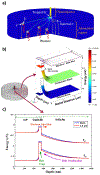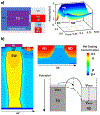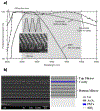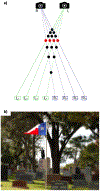Recent advances in infrared imagers: toward thermodynamic and quantum limits of photon sensitivity
- PMID: 32018242
- PMCID: PMC7282310
- DOI: 10.1088/1361-6633/ab72e5
Recent advances in infrared imagers: toward thermodynamic and quantum limits of photon sensitivity
Abstract
Infrared detection and imaging are key enabling technologies for a vast number of applications, ranging from communication, to medicine and astronomy, and have recently attracted interest for their potential application in optical interconnects and quantum computing. Nonetheless, infrared detection still constitutes the performance bottleneck for several of these applications, due to a number of unsolved challenges, such as limited quantum efficiency, yield and scalability of the devices, as well as limited sensitivity and low operating temperatures. The current commercially dominating technologies are based on planar semiconducting PIN or avalanche detectors. However, recent developments in semiconductor technology and nano-scale materials have enabled significant technological advancement, demonstrating the potential for groundbreaking achievements in the field. We review the recent progress in the most prominent novel detection technologies, and evaluate their advantages, limitations, and prospects. We further offer a perspective on the main fundamental limits on the detectors sensitivity, and we discuss the technological challenges that need to be addressed for significative advancement of the field. Finally, we present a set of potential system-wide strategies, including nanoscale and low-dimensional detectors, light coupling enhancement strategies, advanced read-out circuitry, neuromorphic and curved image sensors, aimed at improving the overall imagers performance.
Figures



















Similar articles
-
A Method to Correct the Temporal Drift of Single-Photon Detectors Based on Asynchronous Quantum Ghost Imaging.Sensors (Basel). 2024 Apr 18;24(8):2578. doi: 10.3390/s24082578. Sensors (Basel). 2024. PMID: 38676195 Free PMC article.
-
Emerging Single-Photon Detectors Based on Low-Dimensional Materials.Small. 2022 Feb;18(5):e2103963. doi: 10.1002/smll.202103963. Epub 2021 Oct 10. Small. 2022. PMID: 34632717 Review.
-
Superconducting single-photon detectors in the mid-infrared for physical chemistry and spectroscopy.Chem Soc Rev. 2023 Feb 6;52(3):921-941. doi: 10.1039/d1cs00434d. Chem Soc Rev. 2023. PMID: 36649126 Review.
-
High performance planar germanium-on-silicon single-photon avalanche diode detectors.Nat Commun. 2019 Mar 6;10(1):1086. doi: 10.1038/s41467-019-08830-w. Nat Commun. 2019. PMID: 30842439 Free PMC article.
-
Emerging Thermal Detectors Based on Low-Dimensional Materials: Strategies and Progress.Nanomaterials (Basel). 2025 Mar 18;15(6):459. doi: 10.3390/nano15060459. Nanomaterials (Basel). 2025. PMID: 40137632 Free PMC article. Review.
Cited by
-
Sub-millikelvin-resolved superconducting nanowire single-photon detector operates with sub-pW infrared radiation power.Natl Sci Rev. 2024 Sep 14;12(1):nwae319. doi: 10.1093/nsr/nwae319. eCollection 2025 Jan. Natl Sci Rev. 2024. PMID: 39822729 Free PMC article.
-
2D compounds with heterolayered architecture for infrared photodetectors.Chem Sci. 2024 Sep 9;15(39):15983-6005. doi: 10.1039/d4sc03428g. Online ahead of print. Chem Sci. 2024. PMID: 39328196 Free PMC article. Review.
-
Dynamically Reconfigurable Data Readout of Pixel Detectors for Automatic Synchronization with Data Acquisition Systems.Sensors (Basel). 2020 Apr 30;20(9):2560. doi: 10.3390/s20092560. Sensors (Basel). 2020. PMID: 32365939 Free PMC article.
-
Graphene nanowalls in photodetectors.RSC Adv. 2023 Jul 28;13(33):22838-22862. doi: 10.1039/d3ra03104g. eCollection 2023 Jul 26. RSC Adv. 2023. PMID: 37520101 Free PMC article. Review.
-
Band-structure-engineered high-gain LWIR photodetector based on a type-II superlattice.Light Sci Appl. 2021 Jan 14;10(1):17. doi: 10.1038/s41377-020-00453-x. Light Sci Appl. 2021. PMID: 33446630 Free PMC article.
References
-
- Fang Y, Armin A, Meredith P and Huang J, “Accurate characterization of next-generation thin-film photodetectors,” Nature Photonics, vol. 13, pp. 1–4, 2019.
-
- Rogalski A, Infrared detectors, CRC press, 2010.
-
- Herschel W, “Experiments on therefrangibility of the invisible rays of the sun,” Phylosophical Transactions of the Royal Society of London, vol. 90, no. 284, 1800.
-
- Case TW, “The Thalofide cell: a new photoelectric substance,” Physical Review, vol. 15, no. 289, 1920.
-
- Hudson RD and Hudson JW, Infrared detectors, Stroudsburg, PA: Dowden, Hutchinson & Ross, 1975.
Grants and funding
LinkOut - more resources
Full Text Sources
